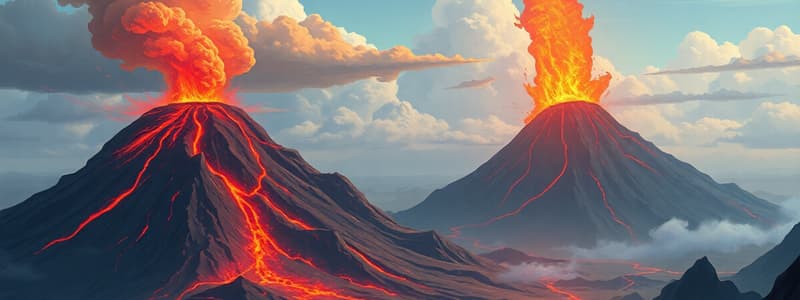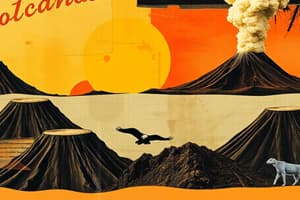Podcast
Questions and Answers
Which type of volcano is characterized by its steep sides and relatively small size?
Which type of volcano is characterized by its steep sides and relatively small size?
- Cinder Cone Volcano (correct)
- Composite Volcano
- Fissure Volcano
- Shield Volcano
What is the primary difference between a volcanic eruption and an explosive eruption?
What is the primary difference between a volcanic eruption and an explosive eruption?
- The amount of gas released
- The rate of lava flow
- The location of the volcano
- The type of magma involved (correct)
Which type of volcano is most likely to produce highly explosive eruptions?
Which type of volcano is most likely to produce highly explosive eruptions?
- Cinder Cone Volcano
- Shield Volcano
- Fissure Volcano
- Composite Volcano (correct)
What is a typical characteristic of a shield volcano?
What is a typical characteristic of a shield volcano?
What is a fissure eruption?
What is a fissure eruption?
Flashcards
Shield Volcano
Shield Volcano
A broad, gently sloping volcano formed by low viscosity lava. Example: Mauna Loa.
Composite Volcano
Composite Volcano
A steep, conical volcano formed from alternating lava flows and ash. Example: Mount St. Helens.
Cinder Cone Volcano
Cinder Cone Volcano
The simplest type of volcano, built from small fragments and eruptions. Example: Paricutin.
Volcanic Eruption
Volcanic Eruption
Signup and view all the flashcards
Lava Flow
Lava Flow
Signup and view all the flashcards
Study Notes
Types of Volcanoes
- Volcanoes are classified based on their shape and the type of eruption they produce. Shape is determined by the viscosity (resistance to flow) of the magma and the nature of the eruptions.
- Shield volcanoes are broad, gently sloping volcanoes built from fluid, basaltic lava flows. They are characterized by massive size and frequent, less explosive eruptions. Eruptions are relatively quiet.
- Cinder cones are small, steep-sided volcanoes built from loose pyroclastic fragments (cinders) ejected from a single vent. They are characterized by short-lived eruptive activity and fairly simple structure.
- Composite volcanoes (stratovolcanoes) are large, cone-shaped volcanoes composed of alternating layers of lava flows and pyroclastic materials. They are characterized by explosive eruptions of viscous andesitic magma, often accompanied by significant pyroclastic flows.
- Calderas are large, roughly circular depressions formed by the collapse of a volcano's summit following a massive eruption. They can be vast and represent the sites of exceptionally powerful volcanic events.
- Lava domes are bulbous, steep-sided structures formed by highly viscous magma that erupts slowly and extrudes rather than flows.
- Subglacial volcanoes emerge and erupt beneath glacial ice. Their eruptions can create distinctive landforms and often involve the interaction of magma with ice.
Types of Volcanic Eruptions
- Effusive eruptions are characterized by the outpouring of fluid lava. Magma with a low viscosity flows easily, creating lava flows that spread over large areas. Lava domes are a common feature of effusive eruptions.
- Explosive eruptions are characterized by the rapid ejection of fragmented volcanic material (pyroclastic material) into the atmosphere. Highly viscous magma produces explosive eruptions. These eruptions create ash clouds, pyroclastic flows, and significant explosions. Different types of explosive eruptions vary in intensity and magnitude.
Studying That Suits You
Use AI to generate personalized quizzes and flashcards to suit your learning preferences.




